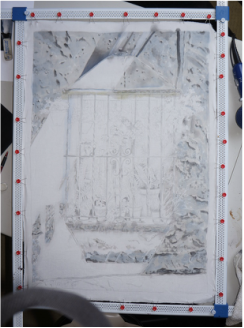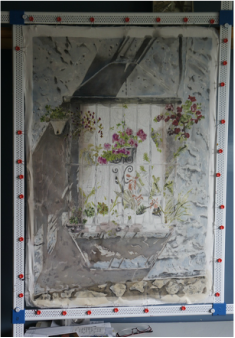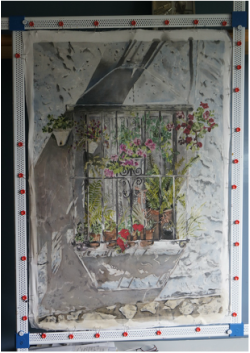What is batik ...
Batik is a fabric dyeing technique originating in Indonesia. It uses wax and dye to create patterns and designs on cloth. The wax can be applied using various tools (canting tools, paint brushes and printing blocks) depending on the final result wanted. Various fabrics can also be used, for instance, rayon, linen, voile, cotton and silk, I use 100% cotton as the dye doesn't bleed quite as fast. Most people who have tried batik have used the dipping technique where wax is used as a resist when dipping the entire piece of fabric in the coloured dye. Another common batik technique which can produce realistic images, involves painting on the dye, not dipping.
I choose to work on cotton, not customary for "painted" batik which, as described, is more commonly done on silk. Cotton allows for somewhat more control as the bleed can be slowed. The usual process where wax is heated and applied to fabric in stages, with intermittent dying, remains the same. The truly artistic aspect of my work involves the control of the dye with and without the wax. When the dye touches the fabric, I let it spread in varying degrees dependent on how wet I allow the fabric to become, and stay. The wax, as usual, can create a boundary where the dye cannot enter. When a piece is finished, the various layers have created a thick coat of wax over the entire piece. Traditionally, at this stage the piece is immersed in a vat of dye during which time the wax randomly cracks, allowing the dye to penetrate the cloth. With my work, I strategically bend the hardened cotton, cracking the wax which I then paint with dye producing the distinctive "crackle" effect so characteristic of the batik process. The wax is finally removed using an iron and the crisp colours are revealed. Batik has become an endless creative challenge for me and I love to test myself to see how far I can take it.
I choose to work on cotton, not customary for "painted" batik which, as described, is more commonly done on silk. Cotton allows for somewhat more control as the bleed can be slowed. The usual process where wax is heated and applied to fabric in stages, with intermittent dying, remains the same. The truly artistic aspect of my work involves the control of the dye with and without the wax. When the dye touches the fabric, I let it spread in varying degrees dependent on how wet I allow the fabric to become, and stay. The wax, as usual, can create a boundary where the dye cannot enter. When a piece is finished, the various layers have created a thick coat of wax over the entire piece. Traditionally, at this stage the piece is immersed in a vat of dye during which time the wax randomly cracks, allowing the dye to penetrate the cloth. With my work, I strategically bend the hardened cotton, cracking the wax which I then paint with dye producing the distinctive "crackle" effect so characteristic of the batik process. The wax is finally removed using an iron and the crisp colours are revealed. Batik has become an endless creative challenge for me and I love to test myself to see how far I can take it.







